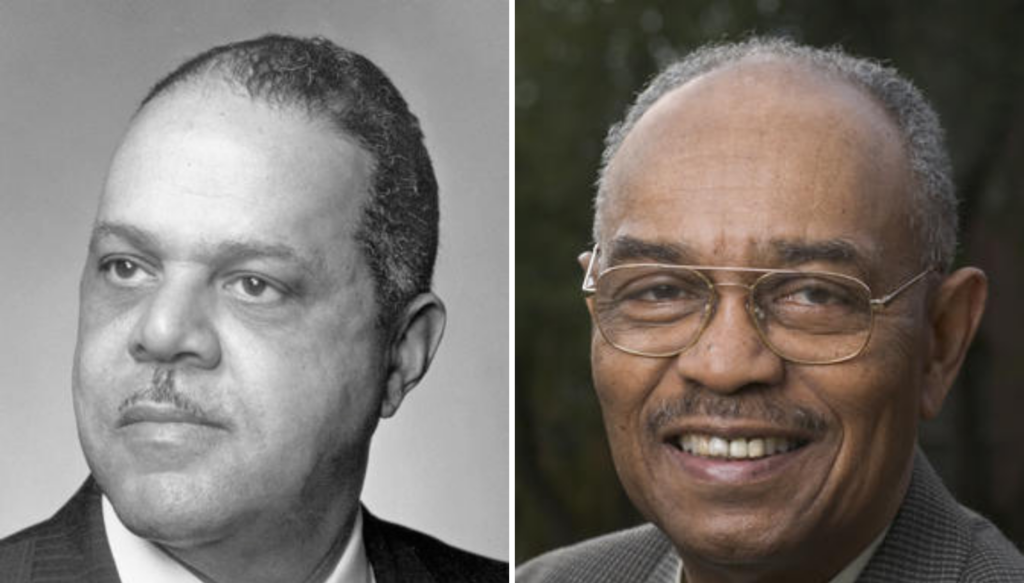The school is giving honor where honor is due!
The University of Massachusetts (UMass) Amherst renamed its Fine Arts building and concert hall in honor of the school’s first Black chancellor and a beloved music educator, UMass reports. The university hosted a renaming ceremony for the Fine Arts Center building and its main concert hall. The building will now be known as the Randolph W. Bromery Center for the Arts, in honor of the university’s first Black chancellor. The center’s 1,800 seat concert hall has also been renamed in honor of Frederick C. Tillis, a beloved music educator, composer, poet, and arts administrator at the university, who passed away last year.
Dr. Bromery was a geologist and geophysicist who began his career at UMass Amherst in 1967. He quickly rose in leadership, going from a professor of geology to the vice chancellor for student affairs. He eventually served as university chancellor from 1971 to 1979. He made history as the first Black chancellor at UMass Amherst and the second Black person to ever lead a Predominantly White Institution. His leadership came during a tumultuous time for the nation; students protesting the war in Vietnam, the infamous Watergate scandal, and the gains of the Civil Rights Movement were in question. There was also a significant influx in student enrollment due to the baby boomer era.
During his tenure, Dr. Bromery promoted equity in student enrollment by actively recruiting students of color and evening out the ratio of male to female students. He also invested heavily in the arts, recruiting jazz legends to his faculty, including Max Roach, Archie Shepp, and Dr. Tillis. Dr. Bromery was also crucial to acquiring the archives of W.E.B. Du Bois and Horace Mann Bond establishing UMass Amherst as a leader in African American studies.
Dr. Tillis joined the faculty under Dr. Bromery, recruited by music department head Phillip Bezanson in 1970. In 1978, Dr. Bromery appointed Dr. Tillis as director of the Fine Arts Center (F.A.C.), which he held for almost two decades. The educator was vital in shaping the cultural and musical foundation at UMass Amherst. He used his expertise as a performer and composer to diversify the arts departments offering. Dr. Tillis launched several initiatives, including the jazz and Afro-American Music Studies program, the jazz in July Summer Music Program, New World Theater, the Augusta Savage Gallery, and the Asian Arts and Culture program.
“It was Chancellor Bromerys approach to the arts that most clearly defines his leadership and his legacy on this campus. After the [Fine Arts Center] opened in 1975, Dr. Fred Tillis became one of its earliest directors, and the two men shared a vision of the arts as fundamentally and necessarily inclusive – and the chancellor was not afraid to challenge the academic status quo to realize that vision,” UMass Amherst Chancellor Kumble Subbaswamy said.
Even after Dr. Tillis’ retirement in 1997, he remained connected to the Fine Arts Center until his death at the age of 90 in 2020. He produced more than 100 compositions throughout his life, including piano, voice, orchestra, chorus, and chamber music works. He also composed several Black spirituals and published 15 books of poetry.
“During his career, Dr. Tillis shaped our concentration in jazz & African American Music – one of the first in the country – into an internationally renowned program. And from the earliest days of the F.A.C., as director, he defined the future trajectory of the center by presenting both Western and non-Western artists and art forms, thereby establishing the university as a national leader in inclusive programming. By shaping our artistic excellence across learning discovery and engagement, Dr. Tillis created an area of strength for the campus, allowing us to build on his legacy,” Subbaswamy said.
The renaming ceremony took place alongside the new arts bridge unveiling, a $12.57 million renovation project the university began last year. It includes a multidisciplinary maker’s space for the departments of art, music, dance, and theater. Subbaswamy credited Professor John Bracey Jr., founder of the campus’ W.E.B. Du Bois Afro-American Studies Department, with the idea to rename the center in honor of Dr. Bromery. The university also announced its new Black Presence Initiative under the direction of Bracey. The new project will unite the stories of Black faculty, students, staff, and alumni, highlighting their contributions to UMass’ 160-year-history.
“What we are truly celebrating today is a legacy of deep commitment – to the arts, arts education, and the university. Dr. Bromery and Dr. Tillis profoundly reshaped UMass Amherst. We’re honoring these campus leaders for the sweeping changes they made in the arts and art education on campus, but we do this mindful that their influence goes well beyond the arts and resonates across campus,” Fine Arts Center director Jamilla Deria said.
Thank you for your contributions Dr. Bromery and Dr. Tillis. Continue to rest in power. Because of you, we can!
(l to r) Randolph W. Bromery & Frederick C. Tillis. Photos Courtesy of UMass Amherst

